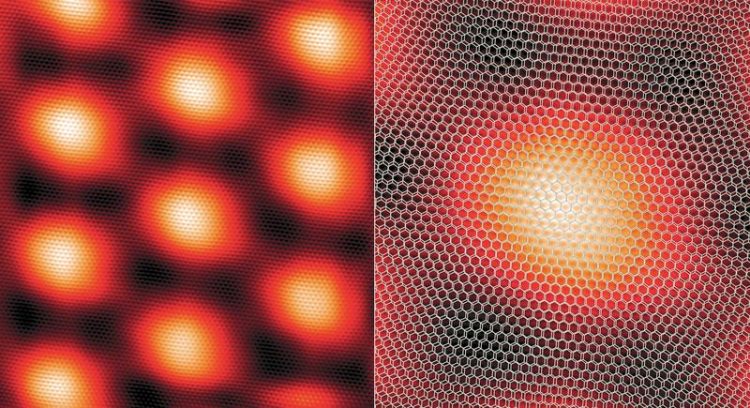New research highlights similarities in the insulating states of twisted bilayer graphene and cuprates

High-resolution STM image of twisted bilayer graphene at the 'magic angle' where electron interactions are maximised. Right: A zoom into the STM image showing the stacked, angled TBLG layers. Alexander Kerelsky, Columbia University
Finding a material which superconducts at room temperature would lead to a technological revolution, alleviate the energy crisis (as nowadays most energy is lost on the way from generation to usage) and boost computing performance to an entirely new level.
However, despite the progress made in understanding these systems, a full theoretical description is still elusive, leaving our search for room temperature superconductivity mainly serendipitous.
In a major scientific breakthrough in 2018, twisted bilayer graphene (TBLG) was shown to exhibit phases of matter akin to those of a certain class of high-Tc superconducting materials – the so-called high-Tc cuprates. This represents a novel inroad via a much cleaner and more controllable experimental setup.
The scientists from the Max Planck Institute for the Structure and Dynamics of Matter (MPSD), Freie Universität Berlin (both in Germany), Columbia University (USA) and the National Institute for Materials Science in Japan focused on the insulating state of TBLG.
This material is made up of two atomically thin layers of graphene, stacked at a very slight angle to each other. In this structure, the insulating state precedes the high- Tc superconducting phase. Hence, a better understanding of this phase and what leads up to it is crucial for the control of TBLG.
The scientists used scanning tunneling microscopy and spectroscopy (STM / STS) to investigate the samples. With this microscopic technique, electrically conducting surfaces can be examined atom by atom. Using the pioneering “tear and stack” method, they placed two atomically thin layers of graphene on top of one another and rotated them slightly. Then, the team directly mapped the material’s atomic-scale structural and electronic properties near the ‘magic angle’ of around 1.1°.
The findings, which have just been published in Nature, cast new light on the factors influencing the emergence of superconductivity in TBLG. The team observed that the insulating state, which precedes the superconducting state, appears at a particular level of filling the system with electrons. It enables scientists to estimate the strength and the nature of the interactions between electrons in these systems – a crucial step towards their description.
In particular, the results show that two distinct van Hove singularities (vHs) in the local density of states appear close to the magic angle which have a doping dependent separation of 40-57 meV. This demonstrates clearly for the first time that the vHs separation is significantly larger than previously thought. Furthermore, the team clearly demonstrates that the vHs splits into two peaks when the system is doped near half Moiréband filling. This doping-dependent splitting is explained by a correlation-induced gap, which means that in TBLG, electron-induced interaction plays a prominent role.
The team found that the ratio of the Coulomb interaction to the bandwidth of each individual vHs is more crucial to the magic angle than the vHs seperation. This suggests that the neighboring superconducting state is driven by a Cooper-like pairing mechanism based on electron-electron interactions. In addition, the STS results indicate some level of electronic nematicity (spontaneous breaking of the rotational symmetry of the underlying lattice), much like what is observed in cuprates near the superconducting state.
With this research, the team has taken a crucial step towards demonstrating the equivalence of the physics of high-Tc cuprates and those of TBLG materials. The insights gained via TBLG in this study will thus further the understanding of high-temperature superconductivity in cuprates and lead to a better analysis of the detailed workings of these fascinating systems.
The team’s work on the nature of the superconducting and insulating states seen in transport will allow researchers to benchmark theories and hopefully ultimately understand TBLG as a stepping stone towards a more complete description of the high-Tc cuprates. In the future, this may pave the way towards a more systematic approach of increasing superconducting temperatures in these and similar systems.
Alexander Kerelsky, Dept. of Physics, Columbia University: a.kerelsky@columbia.edu
Lede Xian, Max Planck Institute for the Structure and Dynamics of Matter: lede.xian@mpsd.mpg.de
Media Contact
All latest news from the category: Materials Sciences
Materials management deals with the research, development, manufacturing and processing of raw and industrial materials. Key aspects here are biological and medical issues, which play an increasingly important role in this field.
innovations-report offers in-depth articles related to the development and application of materials and the structure and properties of new materials.
Newest articles

Silicon Carbide Innovation Alliance to drive industrial-scale semiconductor work
Known for its ability to withstand extreme environments and high voltages, silicon carbide (SiC) is a semiconducting material made up of silicon and carbon atoms arranged into crystals that is…

New SPECT/CT technique shows impressive biomarker identification
…offers increased access for prostate cancer patients. A novel SPECT/CT acquisition method can accurately detect radiopharmaceutical biodistribution in a convenient manner for prostate cancer patients, opening the door for more…

How 3D printers can give robots a soft touch
Soft skin coverings and touch sensors have emerged as a promising feature for robots that are both safer and more intuitive for human interaction, but they are expensive and difficult…





















